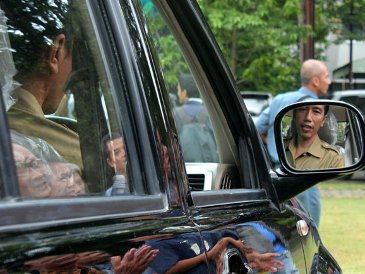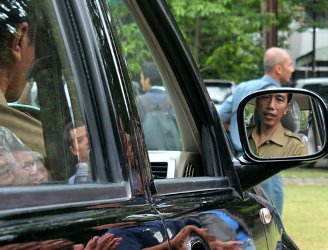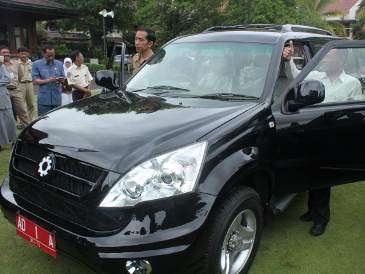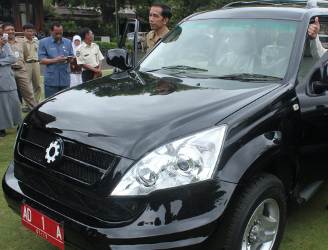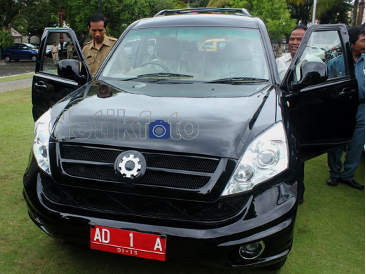Bengawan Solo River (alternatively,
Solo River, with
Bengawan being an
Old Javanese word for
river) is the longest river on the
Indonesian island of
Java, approximately 600 km in length. Apart from its importance as watercourse to the inhabitants and farmlands of the eastern and northern parts of the island, it is a renowned region in
paleoanthropology circles. Many discoveries of early
hominid remains have been made at several sites in its valleys, especially at
Sangiran, including that of the first early human fossil found outside of Europe, the so-called "
Java Man" skull.
Bengawan Solo was the crash site of
Garuda Indonesia Flight 421.
[2]
[edit] Geography
The Bengawan Solo River has its source at the
volcano of
Mount Lawu, in the border of
Central Java and
East Java. It passes through the major city of
Surakarta (called
Solo by the local inhabitants). An important early tributary to the Solo river is Dengkeng river, which has its source in
Mount Merapi.
[3] After passing through Solo, the river flows northward around Mount Lawu, and then turn eastward into
East Java in the
Ngawi regency.
After Ngawi the river turned northward again, forming the boundary between
Blora regency of Central Java and
Bojonegoro regency of East Java. From town of Cepu in Blora, the river turned eastward and passed through Bojonegoro regency's capital city. From there, it continues eastward through
Lamongan and
Gresik regency. The last part of the river's basin (roughly starting from Bojonegoro regency) is mostly flat land.
[4]
Bengawan Solo delta is located near the town of Sedayu in Gresik regency. The present delta is redirected by human made
canal.
[4] The original delta flowed into
Madura Strait,
[4] but in 1890 a 12-km canal was made by
Dutch East Indies authority to redirect the Solo river into
Java Sea.
[4][5] This is to prevent sedimentation of mud from filling Madura Strait and preventing sea access of important port city of
Surabaya.
[4]
The Solo river
delta has a huge mud
sedimentation flow that deposited 17 million tonne of mud per year. This sedimentation in the delta form a cape, which has average longitudinal growth of 70 m per year.
[5] This delta is known as Ujung Pangkah (Pangkah Cape).
[edit] History
Solo river was part of massive river system that once existed in
Sundaland. This drainage of the river system consisted of major river in present-day
Sumatra and
Borneo, such as Asahan river,
Musi river and
Kapuas river. The river system disappeared when Sundaland was submerged after sea level rise following the last Ice Age less than 10.000 years ago.
[6]
The river played important part in Javanese history. Its drainage basin is an important agricultural area, dominated by
rice farming. The river transported fertile volcanic soil downstream, replenishing the soil. It also provided link between Javanese port cities in the northern coast and the rice-growing hinterlands, with shallow vessels transporting rice to he ports to be sold.
[7] This rice is Java's main commodity that was traded as part of the
Spice trade.
Following acquisition of much of Java by the Dutch colonial governmental, various
cash crops was introduced to be planted across the river basin, such as
coffee,
sugar and
cotton. (see
Cultivation System).
By the last years of 19th century, river sedimentation in its original delta in Madura Strait started to disrupt vessels traffic in port of Surabaya. The Dutch colonial government decided to divert the river flow away from the shipping lane into
Java Sea. They built a canal in the river's delta in 1890s which still alter the river until this day.
[8]
In 1891, Dutch paleoanthropologist
Eugène Dubois discovered remains of what he described as "a species in between humans and apes". He called his finds
Pithecanthropus erectus ("ape-human that stands upright") or
Java Man. Today, they are classified as
Homo erectus ("human that stands upright").
[9] These were the first specimens of early
hominid remains to be found outside of Africa or Europe.
